The headline inflation of prices in Davao de Oro decreased at -1.2 percent in February 2025 from January 2025. This brings the provincial average inflation rate to -0.2 percent. The inflation rate in February 2024 was observed at 4.9 percent. (Table 1 and Figure 1)
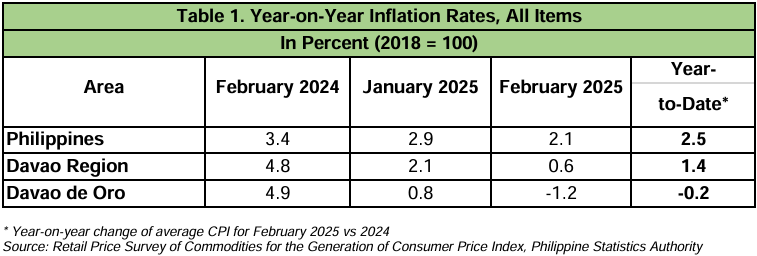
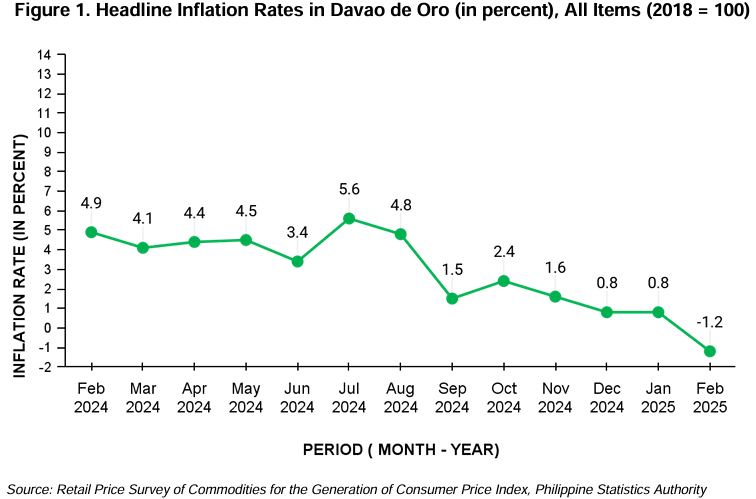
The downtrend of provincial inflation in February 2025 was mainly driven by the lower annual growth rate in the indices of the following commodity groups: (a) Food and non-alcoholic beverages at -4.1 percent from -0.6 in January 2025; (b) Transport at -1.6 percent from 0.2 percent in January 2025 and; (c) Furnishings, Household Equipment and Routine Household Maintenance at 2.7 percent from 3.8 percent in January 2025. (Table 2)
The percentage share of the above-mentioned commodity groups in the overall inflation in February 2025 are as follows: (a) Food and non-alcoholic beverages with 88.1 percent; (b) Transport with 7.5 percent and; (c) Furnishings, Household Equipment and Routine Household Maintenance with 1.8 percent.
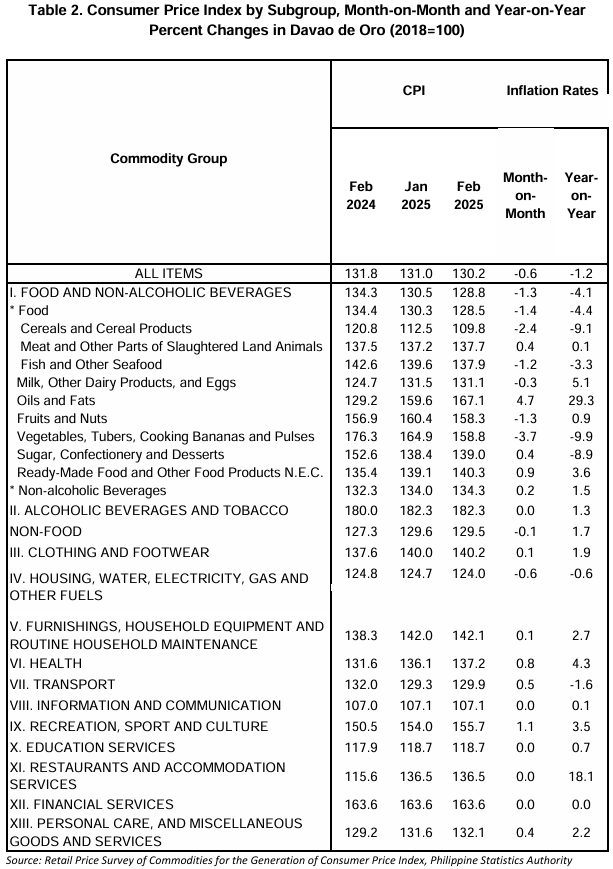
Moreover, the following commodity groups also posted a slower annual growth in their respective inflation for the month of February 2025:
a. Alcoholic beverages and tobacco at 1.3 percent;
b. Clothing and footwear at 1.9 percent; and
c. Personal care, and miscellaneous goods and services at 2.2 percent.
On the other hand, the following commodity groups posted a faster annual increment in their respective inflation rate for the month of February 2025:
a. Health at 4.3 percent; and
b. Recreation, sport and culture at 3.5 percent.
In addition, the following commodity groups posted slower annual decline in their respective inflation rate from year-on-year percentage annual drop:
a. Housing, water, electricity, gas and other fuels at -0.6 percent from -0.4 percent.
Meanwhile, the indices of the following commodity groups remained at their respective previous month’s annual rates:
a. Information and Communication at 0.1 percent;
b. Education services at 0.7 percent;
c. Restaurants and accommodation services at 18.1 percent; and
d. Financial Services with zero percent.
The Food and non-alcoholic beverages commodity group had the highest contribution for the month’s inflation rate with 179.5 percent share (-2.15 points). As to the share to the month’s inflation rate of the said commodity group, Cereals and Cereal Products posted the highest percentage share of 157.1 percent (-1.89 points) and having a -9.1 percent inflation rate. This was followed by Vegetables, tubers, plantains, etc. with a 34.0 percent share (0.41 points) and -9.9 percent inflation rate. Fish and other seafood had the third highest percentage share of 23.3 percent (-0.28 points) with -3.3 percent inflation rate. (Table 3)

The second highest contributor is the Transport commodity group with 11.6 percent share (-0.14 points) among all items. As to the share to the month’s inflation rate of the said commodity group, Fuels and lubricants for personal transport equipment posted the highest share of 21.7 percent (-0.26 points) with -6.6 percent inflation rate. This was followed by Parts and accessories for personal transport equipment with a -0.6 percent share (0.01 points) and 1.4 percent inflation rate. (Table 4)

The Housing, water, electricity, gas, and other fuels commodity group ranked third with a 9.2 percent contribution (-0.11 points). As to the share to the month’s inflation rate of the said commodity group, electricity posted the highest share of 10.8 percent (-0.13 points) with -3.6 percent inflation rate. (Table 5)


Below is the summary of inflation rates in Davao de Oro Province since the rebasing of the market basket with 2018 as the base year.
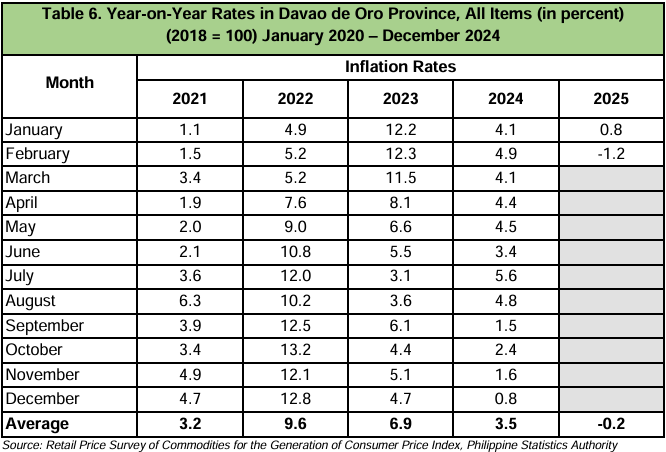
Consequently, the Purchasing Power of Peso (PPP) with base year 2018 in Davao de Oro is equivalent to 0.77 in February 2025.
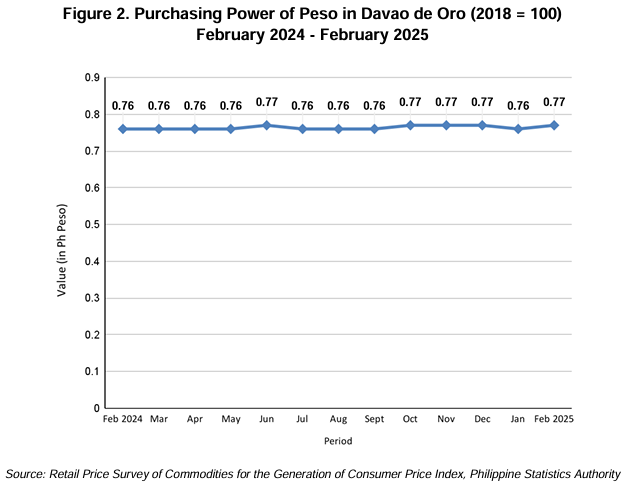
Technical Notes
Price – is the amount or value paid in exchange for the commodity, or a service rendered.
Retail/Consumer Price – refers to the price at which a commodity is sold in small quantities for consumption.
Market Basket – a term used to refer to a sample of goods and services that are commonly purchased and bought by an average Filipino household.
Consumer Price Index (CPI) – it is an indicator of the change in the average retail prices of a fixed basket of goods and services commonly purchased by an average Filipino household. It shows how much on the average, prices of goods and services have increased or decreased from a particular reference period known as base year.
Inflation Rate – is an indicator derived from the CPI. It refers to the annual rate of change or the year-on-year change of the CPI expressed in percent. Inflation is interpreted in terms of declining purchasing power of money.
Weight – a value attached to a commodity or group of commodities depending on the magnitude of its contribution to the index.
Base Period – a reference date at which the index is equal to 100. Base year is 2018.
Index Methodology – a Laspeyre’s formula: fixed base year and weights.
Purchasing Power of the Peso (PPP) – the measure of how much the peso in the base period is worth in the current period.
Percentage Change – is a simple mathematical concept that represents the degree of change over time. It is used for many purposes in finance, often to represent the price change of a security.
Headline Inflation – measures changes in the cost of living based on movements in the prices of a specified basket of major commodities. It refers to the annual rate of change or the year on-year change in the Consumer Price Index (CPI).
